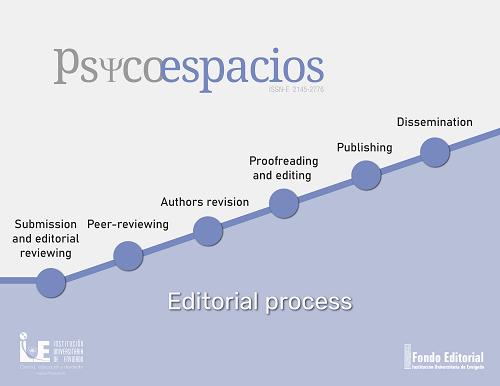Submissions
Submission Preparation Checklist
As part of the submission process, authors are required to check off their submission's compliance with all of the following items, and submissions may be returned to authors that do not adhere to these guidelines.-
The manuscript has not been previously published or submitted to any other journal
- The file was sent in OpenOffice, Microsoft Word, RTF or WordPerfect
- Web addresses have been included for references when necessary
- The manuscript complies with citation and style standards at https://revistas.iue.edu.co/index.php/Psicoespacios/about/submissions
- Author names are missing from the manuscript and the author's name has also been removed from the document properties to ensure blind review
- The ORCID identifier is included in the "Author Information" format
- Authors have updated their Google Scholar profile and have their link included in the "Author Information" format
- Colombian authors have updated their CvLAC profile and have their link included in the "Author Information" format.
- The author information form, available in the instructions for authors, has been filled out completely and correctly
- The manuscript information form, available in the instructions for authors, is filled in completely and correctly, specifying whether the article is the result of research or a thesis
- Original files with all tables (.doc, .docx) are included. All figures (TIF, JPG, PNG formats) and graphics are of high quality
-
The document is single-spaced, with a 12-point font size, and all illustrations, figures and tables are in the appropriate place in the text
Research
Texts that provide research results for the first time and whose writing and publication follow specific standards, accepted by the international scientific community, which guarantee the effective communication of scientific information worldwide. Its structure includes introduction, methods, materials, results, conclusions, and references.
Review or meta-analysis
Documents that analyze, systematize, and integrate the results of published and unpublished research to report on progress and development trends. They are characterized by a careful bibliographic review of at least 50 references.
Reflections
Texts reporting research results from an analytical or critical perspective, on a specific topic, using original scientific sources.
Copyright Notice
Copyright notices proposed by Creative Commons
1. Proposed Policy for Journals Offering Open Access
Those authors who have publications with this journal, accept the following terms:
Authors will retain their copyright and guarantee the journal the right of first publication of their work, which will be simultaneously subject to the Creative Commons Recognition License that allows third parties to share the work as long as its author is indicated and its first publication this magazine.
Authors may adopt other non-exclusive license agreements for the distribution of the version of the published work (eg: deposit it in an institutional telematic archive or publish it in a monographic volume) provided that the initial publication in this journal is indicated. .
Authors are allowed and recommended to disseminate their work through the Internet (eg, in institutional telematic files or on their website) before and during the submission process, which can lead to interesting exchanges and increase citations of the published work. (See The effect of open access).
2. Proposed Policy for Journals Offering Deferred Open Access
Those authors who have publications with this journal, accept the following terms:
Authors will retain their copyright and guarantee the journal the right of first publication of their work [SPECIFY PERIOD OF TIME], which will be simultaneously subject to the Creative Commons Recognition License that allows third parties to always share the work that its author and its first publication are indicated in this journal.
Authors may adopt other non-exclusive license agreements for the distribution of the version of the published work (eg: deposit it in an institutional telematic archive or publish it in a monographic volume) provided that the initial publication in this journal is indicated. .
Authors are allowed and recommended to disseminate their work through the Internet (eg, in institutional telematic files or on their website) before and during the submission process, which can lead to interesting exchanges and increase citations of the published work. (See The effect of open access).
Privacy Statement
Los nombres y direcciones de correo electrónico incluidos en esta revista se usarán exclusivamente para los fines declarados y no estarán disponibles para ningún otro propósito u otra persona.
Los datos personales incluidos en la revista Psicoespacios son propiedad de sus titulares, quienes autorizan su tratamiento conforme lo indica la Política de privacidad de la Institución Universitaria de Envigado, disponible en su sitio web.


 Attribution — You must give appropriate credit, provide a link to the license, and indicate if changes were made.
Attribution — You must give appropriate credit, provide a link to the license, and indicate if changes were made.  NonCommercial — You may not use the material for commercial purposes.
NonCommercial — You may not use the material for commercial purposes.  ShareAlike — If you remix, transform, or build upon the material, you must distribute your contributions under the same license as the original.
ShareAlike — If you remix, transform, or build upon the material, you must distribute your contributions under the same license as the original. 


